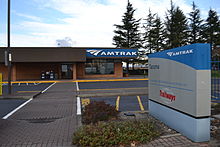The dominant intercity transportation link between Tacoma and other parts of the Puget Sound is Interstate 5, which links Tacoma with Seattle to the north and Portland, Oregon, to the south. State Route 16 runs along a concrete viaduct through Tacoma's Nalley Valley, connecting Interstate 5 with Central and West Tacoma, the Tacoma Narrows Bridge, and the Kitsap Peninsula. Seattle-Tacoma International Airport lies 22 miles (35 km) north, in the city of SeaTac.
Public transportation
A Tacoma Link light rail train on Commerce Street
Sound Transit, the regional transit authority, provides weekday Sounder Commuter Rail service and daily express bus service to and from Seattle. Sound Transit has also established Tacoma Link light rail, a 1.6-mile (2.6 km) free electric streetcar line linking Tacoma Dome Station with the University of Washington, Tacoma, Tacoma's Museum District, and the Theater District. Expansion of the city's rail transit system is currently in planning stages by the city of Tacoma and Sound Transit. The line will be extended north along Commerce St/Stadium Way and then west along Division Ave. It will then turn south along Martin Luther King Jr Way and end near South 19th Street.
The Washington State Ferries system, which has a dock at Point Defiance, provides ferry access to Tahlequah at the southern tip of Vashon Island.
The Amtrak station in Tacoma.
Amtrak, the national passenger rail system, provides service to Tacoma from a station on Puyallup Avenue, one block east of the Tacoma Dome Station. The Cascades trains, operating as far north as Vancouver, British Columbia and as far south as Eugene, Oregon, serve Tacoma several times daily in both directions. The long-distance Coast Starlight operates daily between Seattle and Los Angeles via the San Francisco Bay Area.
Public utilities
Tacoma's relationship with public utilities extends back to 1893. At that time the city was undergoing a boom in population, causing it to exceed the available amount of fresh water supplied by Charles B. Wright's Tacoma Light & Water Company. In response to both this demand and a growing desire to have local public control over the utility system, the city council put up a public vote to acquire and expand the private utility. The measure passed on July 1, 1893, with 3,195 in favor of acquiring the utility system and 1,956 voting against. Since then, Tacoma Public Utilities (TPU) has grown from a small water and light utility to be the largest department in the city's government, employing about 1,200 people.Tacoma Power, a division of TPU, provides residents of Tacoma and several bordering municipalities with electrical power generated by eight hydroelectric dams located on the Skokomish River and elsewhere. Environmentalists, fishermen, and the Skokomish Indian Tribe have criticized TPU's operation of Cushman Dam on the North Fork of the Skokomish River; the tribe's $6 billion claim[48] was denied by the U.S. Supreme court[49] in January 2006. The capacity of Tacoma's hydroelectric system as of 2004 was 713,000 kilowatts, or about 50% of the demand made up by TPU's customers (the rest is purchased from other utilities). According to TPU, hydroelectricity provides about 87% of Tacoma's power; coal 3%; natural gas 1%; nuclear 9%; and biomass and wind at less than 1%. Tacoma Power also operates the Click! Network, a municipally owned cable television and internet service. The residential cost per kilowatt hour of electricity is just over 6 cents.
Tacoma Water provides customers in its service area with water from the Green River Watershed. As of 2004, Tacoma Water provided water services to 93,903 customers. The average annual cost for residential supply was $257.84.
Tacoma Rail, initially a municipally owned street railway line running to the tideflats, was converted to a common-carrier rail switching utility. Tacoma Rail is self-supporting and employs over 90 people.
In addition to municipal garbage collection, Tacoma offers commingled recycling services for paper, cardboard, plastics, and metals.


No comments:
Post a Comment